
- Homepage
- Author
- Aleister Crowley (6)
- Arthur Von Mayer (15)
- Bram Stoker (8)
- Charles Dickens (9)
- Dan Brown (7)
- Dr. Seuss (16)
- Ernest Hemingway (9)
- Frank Herbert (9)
- George Orwell (12)
- Ian Fleming (5)
- J.k. Rowling (43)
- J.r.r. Tolkien (16)
- Kurban Said (5)
- L. Frank Baum (7)
- Margaret Mitchell (8)
- Mark Twain (7)
- Robert Paul Smith (6)
- Rudyard Kipling (9)
- Stephen King (28)
- Unknown (5)
- Other (2197)
- Illustrator
- Arthur Rackham (10)
- Austin Osman Spare (2)
- Black Magic (3)
- Esther Warren (2)
- Garth Williams (2)
- J. R. R. Tolkien (3)
- Jenia Graman (5)
- John Leech (2)
- John Pound (2)
- John Tenniel (3)
- Ken Sugimori (4)
- Marc Chagall (2)
- Mary Grandpre (7)
- Mary Grandpré (2)
- Michael Whelan (4)
- Not Stated (9)
- Sidney Paget (2)
- Thomas Taylor (11)
- Unknown (6)
- Various (6)
- Other (2340)
- Origin
- Publisher
- Alfred A. Knopf (25)
- Bloomsbury (22)
- Chilton (7)
- Doubleday (25)
- Dutton (9)
- Easton Press (13)
- Franklin Library (11)
- G.p. Putnam's Sons (9)
- Grosset & Dunlap (10)
- Harper & Brothers (16)
- Harper & Row (15)
- Harvard Classics (8)
- Jonathan Cape (8)
- Macmillan (19)
- Marvel Comics (10)
- Random House (41)
- Scholastic Press (8)
- Steiger (15)
- The Viking Press (8)
- Viking Press (12)
- Other (2136)
- Subject
- Americana (28)
- Art & Photography (86)
- Children's (104)
- Cooking (8)
- Exploration & Travel (23)
- History (114)
- Illustrated (27)
- Law & Government (7)
- Literature & Fiction (435)
- Men (6)
- Military & War (14)
- Outdoor & Nature (8)
- Philosophy (15)
- Poetry (9)
- Reference (9)
- Science & Medicine (37)
- Science Fiction (5)
- Self-help (10)
- Sports & Recreation (9)
- Vintage Paperbacks (5)
- Other (1468)
- Year Printed
Scarce 1809 Curtis Botanical Hand-Colored Folio Engraving No. 1237, TIGER LILY
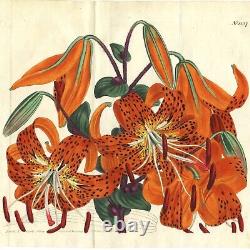
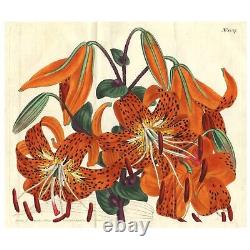
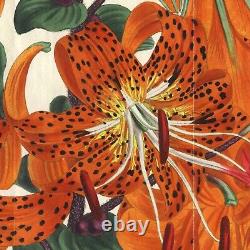
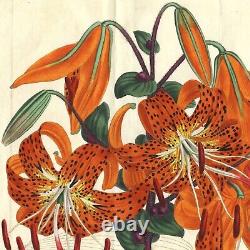
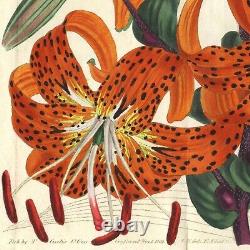
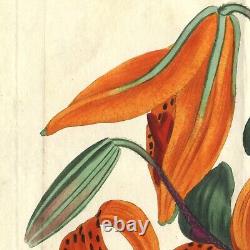
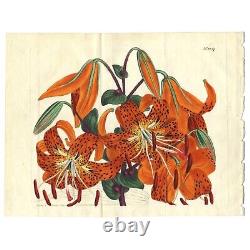
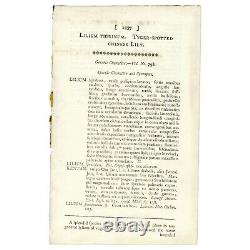
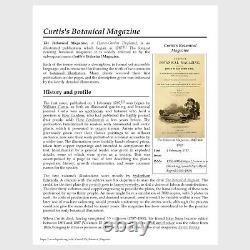


Rare 1809 Hand-Colored Copperplate Engraving from. The Botanical Magazine or Flower-Garden Displayed'. From early volumes of "The Botanical Magazine; or Flower-Garden Displayed" comes this original, Double, fold-out folio copperplate engraving, a rare & sought-after large-format plate from the scarce early volumes. This is my other (last) copy of this plate, the other was acquired. This one is a stunner.
It's in excellent condition for a print this old, about as beautiful a copy as I've ever seen. Undoubtedly one of the most impressive plates of the entire series, imo. The drawing alone is quite magnificent, how each curling petal is actualized from so many angles. The hand-painted coloring is quite spectacular. Scanners don't seem to handle the subtle off-whites of antique print backgrounds, & often skew the other colors as well as the backgrounds.
I've done my best to correct the colors to actual. This plate is now extremely scarce, I find no other copies offered anywhere. If you've been wanting to collect this plate, this is your chance to acquire a near pristine one. The Double-sized fold-out plates were reserved for the showiest, most dramatic, largest flowers.
They were very rare in the series, & yet much more rare in the market, as they can often make the most impressive framed wall-art in terms of scale & image & are sought-after if & when one can be found. This plate is one of the classics of the Curtis volumes.This one is likely a First Edition print, which are generally very rare. Appears to be on the original wove paper, which came to be used in the early years of the 1800's.
After the death of William Curtis, the magazine was published by his brother, Thomas Curtis. Later, Samuel Curtis (a son-in-law of William Curtis) became proprietor from 1801 to 1845. The prints in the first volumes were copper plates colored by hand.Some of the later prints were lithographs. Some of the distinguished artists were Sydenham Edwards, John Curtis, William Jackson Hooker, W. Fitch, William Graves and Matilda Smith.
These prints have a universal beauty and are a lasting documentary contribution to botanical studies. The Artists: This plate was engraved & hand-colored after a painting by Sydenham Edwards & is signed by'Syd. (Sydenham Teak Edwards, 1768 - 1819) as well as the engraver,'F. The drawing & composition are fluid, bold, lyrical, the coloring is stunning, brilliant, bright.
It's one of the boldest of the Sydenham Edwards double plates. These gorgeously drawn, engraved & water-colored original prints were presented on their page with consistently balanced, beautiful compositions. They are full of the passion that the early flower painters, botanists & gardeners had for these amazing flowers, many of which were discovered in the pristine reaches of the ever-expanding British Empire & by intrepid explorers of the time. Every part of these prints was made by hand: Hand drawn & engraved on Copper which was hand-mined, smelted & rolled, printed onto handmade cotton rag paper, inked & colored with hand-ground pigments individually by hand, & they were usually hand sewn into handmade leather-bound books.
Condition: Appears to be in excellent condition. The hand-coloring remains sharp & brilliant.
The folds in this one are as-issued & appear in all copies I've seen of this plate, as it's a'fold-out' & much larger than the rest which were octavo-sized bookplates. These prints are very old & may have minor imperfections expected with age, such as some typical age-toning of the paper, oxidation of the old original watercolors, spots, text-offsetting, artifacts from having been bound into a book, etc. Please examine the photos & details carefully. Text Page(s): This one comes with its original text page.
The Tiger Lily, famed garden stunner is now known as Lilium lancifolium syn. It is an Asian species of lily, native to China, Japan, Korea, and the Russian Far East. It is widely planted as an ornamental because of its showy orange-and-black flowers, and sporadically occurs as a garden escapee in North America, particularly the eastern United States including New England, and has made incursions into some southern states such as Georgia. Its common name is tiger lily.
Although this name is ambiguous across several species, it is correctly applied to this species alone. It is cultivated and wild foraged in Asia for its edible bulbs. The cultivar'Splendens' has gained the Royal Horticultural Society's Award of Garden Merit. In Taiwan, both the flower and bulbs are used as food. Size: 9 x 12 inches approximately.
If you'd like to combine & need more time to choose, please send a message & we'll do our best to oblige.

